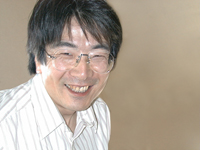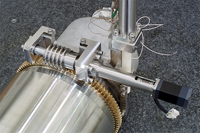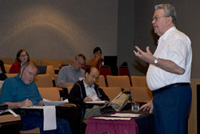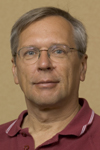 |
|
|
 |
A Statement to the Science Council of Japan

Mitsuaki Nozaki, chair of JHEPC |
The Japan High Energy Physics Committee (JHEPC) issued a statement on 31st August
requesting the Science Council of Japan (SCJ) to endorse a strenuous commitment
of high energy physics community of Japan to the ILC and to encourage early
realization of the project. The request stresses the scientific significance
of the ILC, not only in particle physics but also in understanding the early universe.
It also underlines the world-wide collaborative efforts conducted by the GDE and
a growing Asian collaboration based at KEK facilities. The JHEPC has already
pointed out in 1997 that the next major machine to be built should be a
sub-TeV to TeV linear collider. The Japanese accelerator scientists and particle
physicists have played an important part in R&D activities ever since. Although
the Japanese government is rather prudent in initiating a new project, a BIG
project in particular, the time seems ripe for the ILC being an agenda of funding
agencies. The SCJ is an organization of scientists from all disciplines and
has issued a variety of statements and recommendations to the government
concerning science policy and big projects. An endorsement of the SCJ is
considered to be a crucial step forward in getting government approval
for the project.
The JHEPC has also submitted a request in May this year to the members of
the Council for Science and Technology Policy (CSTP) to promote accelerator
based basic science. The CSTP, chaired by the Prime Minister Koizumi, is
the highest-level general and basic policy making organization whose members
are ministers and eminent opinion leaders from industrial and academic sectors.
It will prepare until the end of this year "The 3rd Science and Technology Basic
Plan" active in the next five years. The JHEPC continues to try producing a
supportive atmosphere for high energy physics, especially for the ILC, in a wide
range of communities.
--Mitsuaki Nozaki, chair of JHEPC
|
 |
|
|
 |
Upcoming meetings, conferences, workshops
ILC Industrial Meeting
Fermilab, USA, 21-22 September, 2005
SMTF Collaboration Meeting
Fermilab, USA, 5-7 October 2005
Nanobeams 2005
Kyoto, Japan, 17-21 October 2005
ECFA ILC Workshop
Vienna, Austria, 14-17 November 2005
TESLA Collaboration Meeting and GDE Meeting
Frascati, Italy, 5-10 December 2005
2006 LCWS 2006
Bangalore, India, 9-15 March 2006
|
ICHIRO Cavity

Test assembly of a coaxial ball screw tuner which has been built
for an L-band 9-cell cavity. (Image courtesy of KEK)
View more test assembly photos
|
|
 |
 |
|
|
 |
Lessons from ITER
CERN DG shares cost-evaluation experience, thoughts on future accelerators

CERN Director General Robert Aymar addressing Global Group 5 at the Snowmass Workshop. |
CERN Director General Robert Aymar discussed lessons from his experience
in costing the ITER project with members of Global Group 5, Cost and
Engineering, at the recent Snowmass ILC Workshop. Aymar led the international team that developed a detailed engineering design for ITER including a cost estimate. As an international scientific project, ITER addressed many of the issues that now confront the proposed International Linear Collider.
"For ITER, we derived the value, not the cost," Aymar said. The team defined an invented currency, the ITER Unit of Account. They then developed some 100 work packages required to build the project and designed the detailed processes for manufacturing with industries from the international partners, thus determining the amount of materials, labor and other elements for each work package. They then valued all of them in a consistent manner throughout the project, expressed in IUA. ITER partner nations could then get "credit" for their share of in-kind contributions in terms of the IUA for the work packages they undertook. The ITER partner nations could "rebuild" the cost of the work packages in their home currencies.
"Two partners contributing in-kind the same component, with the same value in IUA will probably end up with very different costs in their own currencies, compared through exchange rates, because there is no world market for such components," Aymar said. He also advised scientists to keep in mind that government and diplomatic timescales are very different from scientific timescales.
read more
--Perrine Royole-Degieux
|
 |
|
|
 |
Successful Steps for EUDET
"This success is partly due to the good record of international
collaboration in particle physics"
The European initiative for Detector R&D towards the International Linear
Collider (EUDET) was recently selected for funding by the European Union
(EU). Coordinated by Joachim Mnich, a leading scientist at DESY working on
the ILC TPC (and on CMS), this program will support the development and
the construction of larger prototypes of detectors for vertexing, tracking
and calorimetry. It will also provide travel money to encourage networking
between the 25 partners institutes (coming from 9 different EU countries
as well as from Switzerland and Isreal). The EU will support the project
with 7 Million Euros over 4 years. As in other EU schemes the partners
had to commit funds received at the national level to get this extra
funding, thus the total EUDET budget is 21 Million Euros. The program is
focused on the development and the construction of larger prototypes of
detectors for vertexing, tracking and calorimetry. These larger prototypes
are needed now to further test candidate technologies for the ILC
detector.
After CARE and EUROTeV, EUDET is the third successful bid at the EU level
for R&D funds toward the ILC. According to Joachim Mnich this shows very
clearly the high appreciation of the ILC at the EU. This success is
certainly also due to the good examples provided by the ongoing EU
supported accelerator programs and the good record of international
collaboration in particle physics.
Non-European institutes are most welcome to participate in EUDET. Under
certain conditions limited
support could even be provided.
Other ILC related EU programs:
CARE - Coordinated by R. Aleksan
Budget: 35 Millions Euros (incl. 15 Millions from the EU)
EUROTeV - Coordinated by E. Elsen
Budget: 28 Millions Euros (incl. 9 Millions from the EU)
--Nicolas Delerue
|
|
 |
 |
|
|
 |
EDMS
EDMS. All of us in the ILC design community need to become familiar with
this acronym.
In a generic sense, EDMS stands for "Electronic Document Management System,"
and it is used for software systems that provide an orderly way of organizing
a large number of documents over the lifespan of a project, providing mechanisms
for revisions, traceability, searching, etc. This is a need we are all

Tom Markiewicz will
chair the EDMS Sub-
Committee.
|
familiar with and for those of us in the ILC design effort, we recognize
the need to provide and organize all the work that has already been accomplished,
as well as the work that will be done in the future. However, in a more specific
sense for high energy physics detector or accelerator projects, this acronym has
come to be mean "Engineering Data Management System." In this sense, such a system
also provides the basic design tool environment (CAD/CAM etc), document management system, and work flow that are needed to conduct and carry out a complex project design and implementation like the ILC.
Designing the ILC presents many challenges, not the least being how we will coordinate the design when we are geographically so dispersed. A key to our being able to successfully do this work together relies on our having a very good set of collaboration tools, beginning with a common website having all information available in a timely way, and including collaboration tools for scheduling, videoconferencing, etc. Finally, we need a commonly accessible system that includes all the engineering design tools and documentation that will be needed to carry out the ILC design and implementation.
Read more
--Barry Barish
Director's Corner Archive
|
 |
|
|
 |
From Nature Magazine,
07 September 2005
Career View: Brian Foster, European regional director,
International Linear Collider's Global Design Effort, Oxford,
UK
Physicist takes on large collider project
Believing in things of a size most people can't imagine is part
of a physicist's everyday life. In his work towards the proposed

Brian Foster
|
International Linear Collider (ILC), Brian Foster has gone from
subatomic quarks and leptons to the largest linear collider ever built.
For Foster, this is the biggest step in a career that has seen him building new equipment to take discovery further and influencing the direction of physics by advising the UK government. The ILC will be about 40 kilometres long, able to smash electrons together at 500 billion electronvolts in its search for new dimensions of space and forces of nature, and is likely to cost several billion dollars.
Read more
|
|

